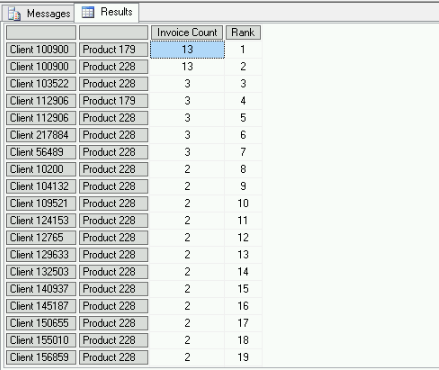14 March 2017
My name is Rank, Dense Rank!
The Rank is one of the functions that wasn’t initially designed for the MDX. Well, it’s possible for sure, however it’s not a first class function. You can easily do ranking using Excel, but the iterating isn’t a strong side of the MDX. You may read a Mosha Pasumansky’s blog post about the Rank function. He explains how to write a C# stored procedure in order to iterate set members. There is a little information about ranking sets with two or more attributes and dense ranking, so, I’ve found it interesting to post a sample here. Let’s go with a simple rank and two attributes:
with
Dynamic Set OrderedSet as
Order(
NonEmptyCrossJoin(
[Client].[Client].[Client].Members,
[Product].[Product].[Product].Members,
[Measures].[Invoice Count],
2
),
[Measures].[Invoice Count],
BDESC
)
Member [Measures].[Rank] as
Rank(
([Client].[Client].Currentmember,[Product].[Product].CurrentMember),
OrderedSet
)
select {[Measures].[Invoice Count],[Measures].[Rank]} on 0,
non empty OrderedSet on 1
from [BI Fake]
where ([Date].[Day].&[20160120])
The result:
Let’s say we want to dense rank it based on a measure value:
with
Dynamic Set OrderedSet as
Order(
NonEmpty(
[Client].[Client].[Client].Members,
[Measures].[Invoice Count]
),
[Measures].[Invoice Count],
BDESC
)
Dynamic Set DenseOrderedSet as
Order(
NonEmpty(
[Client].[Client].[Client].Members,
[Measures].[RankFirstMatch]
),
[Measures].[Invoice Count],
BDESC
)
Member [Measures].[Rank] as
Rank(
[Client].[Client].Currentmember,
OrderedSet
)
Member [Measures].[RankFirstMatch] as
IIF(
[Measures].[Invoice Count]
=
(
OrderedSet.Item([Measures].[Rank] -2),
[Measures].[Invoice Count]
),
NULL,
[Measures].[Rank]
)
Member [Measures].[RankDenseSet] as
Rank(
[Client].[Client].Currentmember,
DenseOrderedSet
)
Member [Measures].[DenseRank] as
IIF(
[Measures].[RankDenseSet] = 0,
(OrderedSet.Item([Measures].[Rank] -2),[Measures].[DenseRank]),
[Measures].[RankDenseSet]
)
select {[Measures].[Invoice Count],[Measures].[Rank],[Measures].[RankFirstMatch],[Measures].[RankDenseSet],[Measures].[DenseRank] } on 0,
non empty OrderedSet on 1
from [BI Fake]
where ([Date].[Day].&[20160120])
The result:
Tags:
Recent Posts:
-
SQL interview tasks #1
12 July 2020
-
How to speed up migration from local DB to Azure
19 November 2018
-
The dynamic members
24 March 2017
-
My name is Rank, Dense Rank!
14 March 2017
-
Web OLAP: Step one
27 December 2016
-
The DistinctCount and its rough edges
30 November 2016
-
Will the SSAS be ported to linux?
17 November 2016
-
The totals and the NonEmptyCrossJoin function
11 November 2016
-
The best DistinctCount practice in SSAS
17 October 2016
-
Generate row set recursively
13 September 2016

